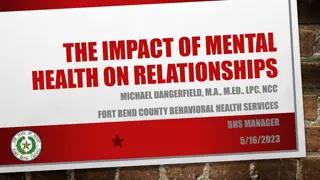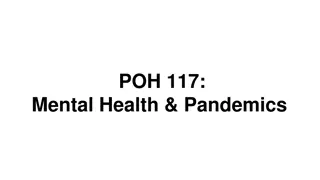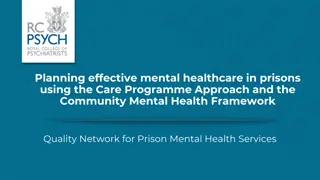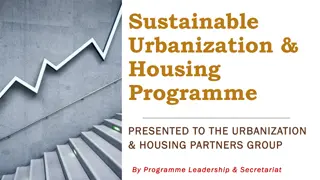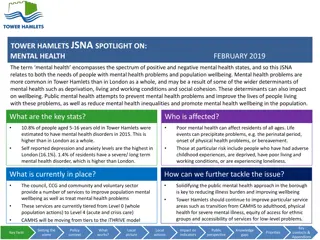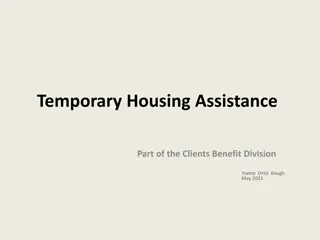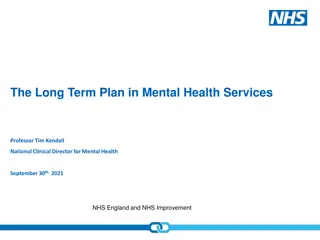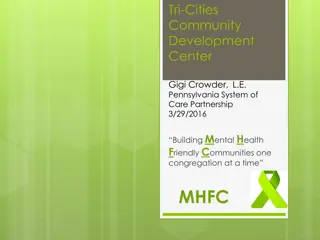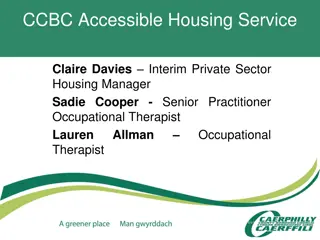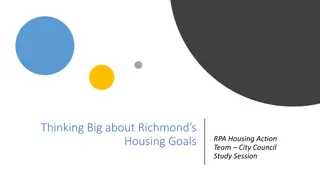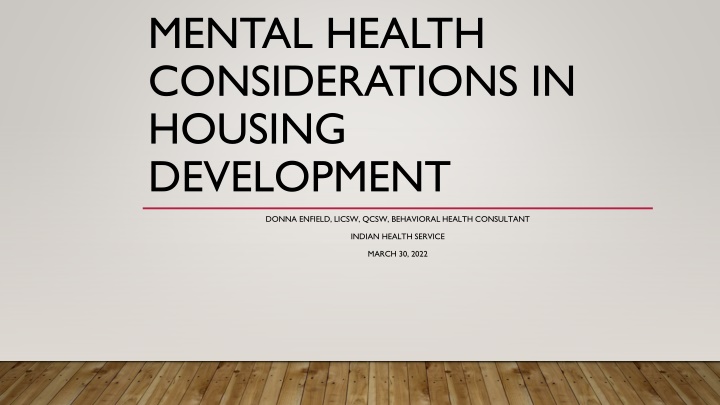
Mental Health Impacts of Housing Development
Explore the crucial relationship between housing and mental health, uncovering statistics on adult and children's mental health issues, suicide rates, and the effects of housing on mental well-being. Discover how improved housing quality can positively impact mental health outcomes and why addressing housing as a social determinant of health is essential for overall well-being.
Download Presentation

Please find below an Image/Link to download the presentation.
The content on the website is provided AS IS for your information and personal use only. It may not be sold, licensed, or shared on other websites without obtaining consent from the author. If you encounter any issues during the download, it is possible that the publisher has removed the file from their server.
You are allowed to download the files provided on this website for personal or commercial use, subject to the condition that they are used lawfully. All files are the property of their respective owners.
The content on the website is provided AS IS for your information and personal use only. It may not be sold, licensed, or shared on other websites without obtaining consent from the author.
E N D
Presentation Transcript
MENTAL HEALTH CONSIDERATIONS IN HOUSING DEVELOPMENT DONNA ENFIELD, LICSW, QCSW, BEHAVIORAL HEALTH CONSULTANT INDIAN HEALTH SERVICE MARCH 30, 2022
HOME SHOULD BE AN ANCHOR, A PORT IN A STORM, A REFUGE, A HAPPY PLACE IN WHICH TO DWELL, A PLACE WHERE WE ARE LOVED AND WHERE WE CAN LOVE. - Marvin J. Ashton
MENTAL HEALTH DATA Approximately 1 in 5 US adults experienced mental illness in the past year (2020 National Health Interview Survey) 11.3% of adults regularly experience worry, nervousness or anxiety (2020 National Health Interview Survey) 4.5% of adults regularly experience feelings of depression (2020 National Health Interview Survey)
CHILDRENS MENTAL HEALTH 5.2% of children aged 5-17 experienced daily feelings of worry, nervousness or anxiety in 2019 (National Center for Health Statistics (2019-2020) CDC WONDER) 5.8% of children aged 5-17 experienced daily feelings of worry, nervousness or anxiety in 2020 (National Center for Health Statistics (2019-2020) CDC WONDER) 2016-2020 increased diagnosis of child anxiety and depression, decreases in physical activity, decreased caregiver mental and emotional health and ability to cope with parenting demands (Lebrun-Harris, et al, 2022)
45,979 Suicide deaths across the US in 2020 (National Vital Statistics System Mortality Data (2020) via CDC WONDER 14.0 suicide deaths per 100,000 population (National Vital Statistics System Mortality Data (2020) via CDC WONDER
WHAT EFFECTS DO HOUSING HAVE ON MENTAL HEALTH? Evidence suggests that mental health can improve with improved housing quality (Evans, Wells, Chan & Saltzman, 2000) Environment impacts stress levels and ability to cope, experience with coping positively affects ability to cope with current stress but fatigue accumulates, may led to disease (Evans & Cohen, 1987) Lack of control over environment consequences: negative affect, cognitive deficits, reduced motivation for positive behavior (Evans & Cohen, Greater improvements in housing show greater improvement in mental health (Evans, Wells, Chan & Saltzman, 2000) Socio-economic status correlates with both housing quality and mental health (Evans, Wells & Moch, 2003)
WHAT EFFECTS DO HOUSING HAVE ON MENTAL HEALTH? Stressful environments result in decreased response to encountered stressful situations, decreased problem-solving ability, reduced interpersonal sensitivity, reduced immunological resistance, increased cardiovascular disorders, increased mental health symptoms, (Evans and Cohen, 1987) Perceptions of increased community investment, connection to others and safety foster increased sense of well-being and increased mental health (Renalds, Smith & Hale, 2010) Heavy drinking occurs more often in lower quality/condition environments and 36-64% more likely to report lifetime depression. (Renalds, Smith & Hale, 2010)
PHYSICAL INFLUENCES OF ENVIRONMENT Transportation via bike or walking, access to recreation facilities, aesthetics, crime and traffic safety (Van Holle, et al, 2015) In neighborhoods viewed as walkable physical activity increased, obesity decreased and mental health improved. Physical activity is influenced by distance to parks or gyms. (Feng, et. al., 2009) Greater walkability was associated with more physical activity independent of socioeconomic and individual factors (Schule and Bolte, 2015) Light in the morning hours and for sleep deprived individuals provides relief, perhaps even faster than anti-depressant medications. (Tuunainen, Kriepke and Endo, 2004) Light plays a part in multiple complex biological functions and may impact mental functioning. (Tuunainen, Kriepke and Endo, 2004) Environmental features have different outcomes dependent upon population ages, activity is influenced by proximity but people self-select where to live. (Feng, J. et al, 2009)
FACTORS THAT INFLUENCE HOUSING SATISFACTION Quality and maintenance are factors in how others view the residents Failure to reside in a home that fits with the residents aspirations may influence self-esteem a symbol of the self Hassles with maintenance, perhaps with housing agencies and bureaucracy Housing instability is linked to socioemotional development problems in children Renting vs. ownership has been linked to poorer health outcomes Safety and hygiene, especially if children are present in the home Actual crime rates and fear of crime *Evans, Wells and Moch (2003)
EFFECTS ON CHILDREN Increased distress, strained relations with parents, fewer playmates and poorer socioemotional development in children with restrictions on play activities and spaces (Evans, Wells & Moch, 2003) Psychological distress and increased classroom conduct issues correlate with crowding in homes defined as greater than 1 person per room, excluding bathrooms, according to the US Census Bureau (Evans, et. al, 2002) More likely to give up on challenging tasks, more likely to let others make choices for them, less likely to engage in new, positive opportunities, learned perception of helplessness or acting out in an effort to demonstrate mastery over environment. (Evans and Cohen, 1987) Noise causes habitual tuning out which affects communication and speech development (Evans and Cohen, 1987)
CONSIDERATIONS TO IMPROVE ENVIRONMENTS Paved bicycle trails have heavier use than unpaved trails Pedestrian-friendly neighborhoods that promote physical activity have residents with lower BMI Higher crime positively associated with probability of overweight children and adults BMI is higher in neighborhoods with fast-food outlets Neighborhood upkeep, decrease in graffiti and streetlights improve perception of safety *Renalds, Smith and Hale, 2010
CONSIDERATIONS TO IMPROVE ENVIRONMENTS Installation of sidewalks Construction and degree of repair Destinations for walking General neighborhood attractiveness Perception of safety Maintenance and safety of schoolyards and playgrounds *Renalds, Smith and Hale, 2010
CONSIDERATIONS TO IMPROVE ENVIRONMENTS Clear visual access to entryways Good lighting maybe facing many windows to the east Adequate play space Intentional social opportunities with neighbors through doorway position, porches, patios, sidewalk intersections, gathering places *Wells and Moch, 2003
CONSIDERATIONS TO IMPROVE ENVIRONMENTS Plenty of light and windows Fresh air, good ventilation Outdoor activity and exercise opportunities and spaces *Bertani, et. al, 2021
ADDITIONAL THINGS TO CONSIDER IN CONSTRUCTION PLANNING Lots of window, orientation to capture morning light Minimize traffic and other noise, soundproofing or trees to buffer sound Intentional traffic flow to increase neighbor socialization Setting homes in groupings to increase neighbor support and socialization Use of green space, plantings important in native culture
ADDITIONAL THINGS TO CONSIDER IN PLANNING FOR AGING IN PLACE Single level living or at least one bedroom and one full bath on the main level Wheelchair access no steps to access the home Electrical outlets set higher on the wall, flip handle doorknobs, crank out windows rather than double-hung with window cranks set low enough to access from w/c height Wider doorways that can accommodate a wheelchair Roll-in shower Ability to remodel bathroom vanity easily if needed Kitchen with at least one section of counter that is wheelchair height appropriate and room to roll through to access appliances Think about things that cannot be changed or cannot be changed easily at the time of construction
RESOURCES Bertani, D.E., DeNovellis, A.M.P., Farina, R., Latella, E., Meloni, M., Scala, D., Valeo, L., Galeazzi, G.M., Ferrari, S., Shedding light on light: A review on the effects on mental health of exposure to optical radiation. Int. J. Environ. Res. Public Health 2021, 18, 1670. https://doi.org/10.3390/ijerph18041670 Evans & Cohen, 1987, Environmental Stress. In D. Stokols & I. Altman (Eds.), Handbook of environmental psychology (pp. 571-610). New York: Wiley. Evans, G. W., Wells, N. M., Chan, H. E., Saltzman, H., Housing Quality and Mental Health, Journal of Counseling and Clinical Psychology (2000) DOI: 10.1037/0022-006X.68.3.526 Evans, G. W., Lercher, P, Kofler, W. W. (2002), Journal of Environmental Psychology, doi:10.1006/jevp256
REFERENCES Feng, J., Gass, T.A., Curriero, F.C., Stewart, W.F., Schwarts, B.S., 2010. The built environment and obesity: a systematic review of the epidemiologic evidence. Health Place 16, 175-190. Lebrun-Harris LA, Ghandour RM, Kogan MD, Warren MD. Five-Year trends in US Children s Health and Well-being, 2016-2020. JAMA Pediatr. Published online March 14, 2022. doi:10.1001/jamapediatrics.2022.0056 National Center for Health Statistics CDC WONDER website Renalds, A., Smith, T. H., Hale, P.J. 2010. A systematic review of built environment and health. Fam. Commun. Health 33, 68-78 Schule, S.A., Bolte, G., 2015. Interactive and independent associations between the socioeconomic and objective built environment on the neighbourhood level and individual health: a systematic review of multilevel studies. PLoS One 10, e0123456.
REFERENCES Tuunainen, A., Kripke D.F., Endo, T. 2004. Light therapy for non-seasonal depression. Cochrane Database of Systematic Reviews 2004, Issue 2. Art. No.: CD004050. Van Holle, V. Deforche, B., Van Cauwenberg, J., Goubert, L. Maes, L., Van de Weghe, N., De Bourdeaudhuij, I, 2012. Rrelationship between the physical environment and different domains of physical activity in European adults: a systemic reviw. BMC Public Health 12, 807. Vahratian, A., Mental Health in the United States: New Estimates from the National Center of Health Statistics, CDC webinar, Sept. 23, 2020 Wells, N.M., Moch, A., 2003. Housing and mental health: A reviw of the evidence and a methodological and conceptual critique, journal of Social Issues. July 2003. DOI: 10.1111/1540- 4560.00074

